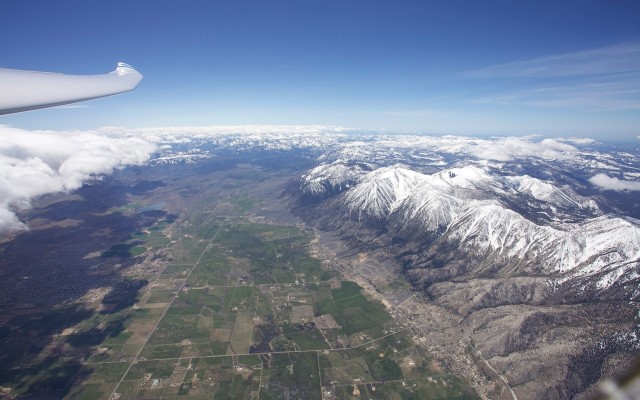
Another amazing photo by Gordon Boettger, from 26,000 feet over the Carson Valley, during a glider wave flight
Let’s pick up where we left off in Gone Gliding, Part Two, shall we?
We’re at Minden-Tahoe Airport in Soaring NV’s LS4 glider, hooked up to the Piper Pawnee towplane, and just starting our takeoff roll. Spencer, our ground crew, runs alongside the glider for a few feet while holding the wingtip. The ailerons are alive in a couple of seconds, and I hold the wings level with the stick, while steering along the runway centerline with the rudder pedals.
With the single main wheel rumbling under my seat, we accelerate quickly as we’re hauled along the runway. A little bit of forward stick gets the LS4’s tail wheel off the ground, and then I move the stick ever-so-gently rearwards. The glider levitates, and we carefully hold position just a few feet in the air, right behind the tow plane. Now that we’re airborne, we’re less drag for the Pawnee, and Silvio lifts off.
I’m primed for a possible rope break, and glance at the altimeter as we cross the end of the runway. It shows a bit under 5,000 feet, and I call out ’œ200 feet!’ We’ve passed the first ’œgate’ at 200 ft above the ground, and if the rope breaks, we can now safely fly a 180-degree turn to land downwind on the runway. Silvio starts a climbing left turn to cross over the airport, and we’re nicely locked in, on tow. The feeling is something like being pulled behind a ski boat, and I’m not even thinking about what I’m doing to the controls, just reacting and flying. Heading east, and crossing over Runway 34, I relax. If the rope breaks now, we’re high enough to easily complete a normal pattern and landing.
As we continue to climb, I call Silvio and tell him that we’d like to ’œbox the wake,’ which is great practice while on tow. He acknowledges, and I start the maneuver by climbing a bit above the towplane, while keeping the rope taut. I stop for a moment, then fly the glider to the right, and stop again at the first corner of the ’œbox.’ Descend a bit, and stop below the towplane at the next corner. Now it’s a slide across the bottom of the box, stopping at the third corner.
Gentle nose up, keep the rope taut, climb above the towplane, and stop at the last corner. Then slide back behind Silvio, hold, and drop back down into the normal tow position, lining up the Pawnee’s horizontal stabilizer with its wing. Smooth, smooth, smooth, all the way around, and I don’t think that I yanked the Pawnee’s tail, even once. I realize that I’m grinning ’“ nailed it!
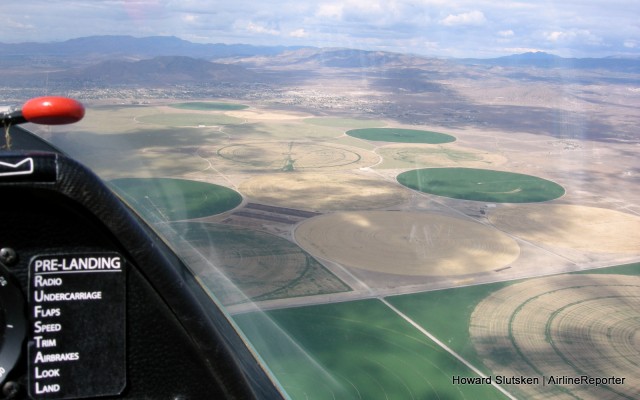
Crop circles east of MEV. Brown circles absorb heat, and create thermals. I took this photo from the ASK-21.
We’re east of MEV now, over the big crop circles. We’re starting to feel some bumps, and the vario is showing some interesting lift. But not enough. A minute later, we watch the towplane jump, and we feel the glider leap. The vario is showing 8 knots up, so count to three to make sure it’s a healthy thermal, then’¦pull the release! The tow rope falls away, and I turn the glider to the right as we watch Silvio peel off in a descending left turn. I give him a quick ’œthanks for the tow’ radio call, and continue the turn to get back into the thermal. The LS4 main wheel retracts into the fuselage, so I pull the gear lever to the up-and-locked position. Now we’ve got a nice, smooth, undraggy glider. I also make note of our 7,500 ft release altitude.
Yup, it’s a good thermal. The vario heads back up, and thinking about my release geometry, I’ll try a right turn to get centered in the thermal. It usually takes a bit of hunting around to figure it out, feeling for the lift, tight bank, then level, then tighten again, go a little further – got it! Around and around we go, climbing steadily in good lift, and moving along with the thermal as it drifts with the wind. I like to think of it as big, gentle, slow moving silo of lift, with the bottom anchored on the ground and the top tilted over in the breeze.
I’m on the rudder all the time, making sure that our turns are coordinated, without any slipping or skidding. It’s something that powered pilots usually have to work on when they fly a glider for the first few times. There’s a nifty, incredibly low-tech device to help guide our turns. Look on the nose, just in front of the canopy, and you’ll see a little piece of yarn. That’s the ’œyaw string.’ If it’s pointing straight back, you’re flying a well-coordinated turn. If it’s on one side or the other, get on the rudder, or your instructor will yell!
We’re through 9,000, then 10,000 feet. The vario is showing less ’˜up’ now, only 2 or 3 knots. We could stay here and try to eke the most out of this thermal, but it’s a case of diminishing returns as we hit the top of it. Let’s look around. There’s another glider north of us, and a lot higher ’“ we’ll head there. Nose down to pick up to the ’œspeed to fly’ between thermals. It’s the best compromise between covering ground while minimizing altitude loss.
Time for a status check. I have a portable pulse-oximeter on a lanyard around my neck. I turn it on, clip it over my fingernail, and see that my oxygen saturation is 95%. Good number. I have to remember to breathe through my nose, to get pure oxygen out of the cannula and into me! Altitude is 10,500 feet, and we’re 6 miles from MEV, so all’s good. Grab a quick drink from my water bottle, and we have a look around at the amazing view as we fly towards the other glider.
We’re starting to nibble into the airspace that our fast-moving, jet pilot friends use on approach into RNO, so let’s give NorCal Approach a call. First, we listen to the Automatic Terminal Information Service (ATIS), which gives us the current weather at RNO, along with info about the runways and approach in use. The ATIS is updated as conditions change, and we’re listening to the sixth update of the day ’“ ’œInformation Foxtrot.’ Now flip the radio over the Nor Cal Approach’s frequency, make sure nobody else is talking, and press the transmit button.
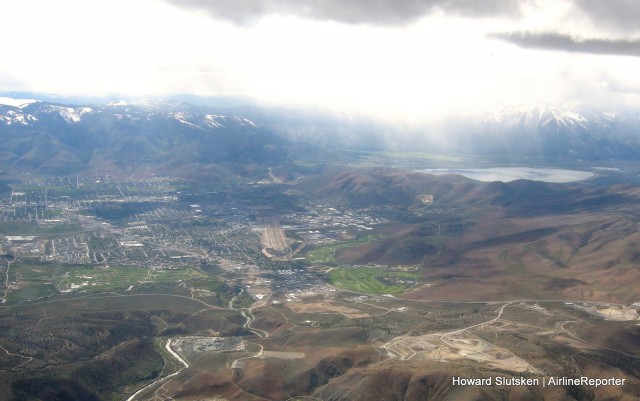
A bit further north than on our flight, that’s Carson City Airport right below, and Lake Washoe. I took this in the Duo Discus.
’œNorCal Approach, Glider 402 Kilo,’ I say. That’s our registration, like our license plate. ’œGlider 402 Kilo, NorCal, go ahead,’ is the reply. My turn. ’œNorCal, 2 Kilo is at 10,500 feet, 6 miles NE of Minden, with ’œFoxtrot’, squawking 1202.’
Remember in pre-flight, we set the transponder to ’œ1202?’ Now, with the aid of that small device, the controller can see us as a nice, clear, digitally-delivered ’œblip’ on her screen, showing our altitude, speed, and direction of flight. Without the transponder, we might not even show up on the screen. Gliders don’t have a whole lot of metal to reflect a radar beam. She probably saw us a bit earlier, but now that we’re calling, she can ’œput a face to the name.’ She says ’œ2 Kilo, Squawk Ident.’
I reach down to the transponder and press the small ’œIdent’ button. Now the controller will see our ’œblip’ blink on the screen, positively identifying us. ’œGlider 2 Kilo, radar contact. What are your intentions?’ I say that we’ll be working thermals in the area, and that we’ll call in our descent back to MEV. She’s good with that, and tells us to ’œhave a good flight.’ We’ll likely only have a call from the controller if we get closer to the approach path to RNO’s Runway 34, and there’s a Southwest 737 or something to watch for.
We’re closing in on the other glider. The pilot is circling to the left in the thermal, so we’ll do the same. That’s one of the ’œrules of the road’ ’“ always circle in the same direction as another glider that’s already established in a thermal. It makes it a lot easier to keep situational awareness. In this case, the other glider is way above us, so there isn’t much of a conflict. But we’ll keep an eye on it.
Wham! The lift whacks me in the seat, the vario pegs, and up we go! Good thing I tightened the belts. Around and around in a left turn, climbing, centering, climbing, just flying the heck out of this thermal. It’s great, and I usually find left turns easier. Why? I hold the stick in my right hand, and left stick is a comfortable move to the open side of my hand and wrist, not the closed side. I’ve looked at some of my flight tracks, and I think 90% of my thermal turns are to the left. I guess I do it automatically.
It doesn’t take us long to climb through 13,000 feet, and to the west, I can see more of Lake Tahoe every time we go around the circle. Beautiful. I see that the other glider has left the thermal, and is heading off to the north-east. The pilot might be doing the 40-mile run down the Pine Nut Mountains, and probably wants to be at 15,000 or 16,000 feet before heading south. But we’ll keep climbing in this powerful thermal. Another status check as we go up through 14,000 feet, and another drink of water. It’s dry up here, and breathing pure oxygen makes us even drier. We have to stay hydrated, although there’s a natural byproduct that we might have to deal with, and there isn’t a lavatory on-board!
There’s a couple of ways that glider pilots’¦decant. Some wear an adult diaper, some wear a catheter that runs to a plastic pouch attached to their leg, and some hook the catheter hose to the glider’s ’œrelief tube,’ that runs to the outside of the fuselage. Open a valve, and you create a new contrail! On the LS4, the relief tube is in the wheel well, so make sure to lower the gear before opening the valve, or it could get messy. Too much information? Maybe so, but it’s something that record-setting pilots like Gordon Boettger have to deal with on their many-hour flights.
Oh. It figures. We’ve been up for about 90 minutes now, and with all of this talk, it seems that we should head back to MEV. We didn’t ’œequip’ ourselves for a long-duration flight, did we? We’ve made it to 16,000 feet in this thermal before it petered out (yup, pun intended), and I make a note of our highest altitude. I’ll open the airbrakes a bit to increase our rate of descent, otherwise we’ll be up here all day. The conditions are that good! I’ll remember to call NorCal, but as we head down, I’ll tell you about my first flight in this glider, as I promised.
Not only was it my first flight in this glider, but my first flight ever in a single-seat glider. Unless you have a simulator to practice in, a first flight in a single-seat plane is, well, the first flight for the pilot. Since he couldn’t ride along, my instructor had given me a detailed briefing on the handling qualities of the LS4, with special emphasis on the CG-hook tow characteristics (go back and read my explanation in Part Two if you don’t know about glider hooks). I was ready to go, and my friend and Master Glider Instructor, Fred Lasor, was the tow plane pilot. With that last name, I don’t think Fred had any choice but to fly gliders. It was clear, but breezy and a bit gusty. I was nervous, but excited and focused, as we started rolling.
I was nicely in position on tow as Fred lifted off. But then, not more than a few hundred feet above the ground, we flew into what we later figured was ’œclear air rotor.’ Rotor clouds develop in wave, look like giant cotton balls, but are nasty. Lots of turbulence, and if you fly through one, you might end up being along for the ride instead of in control of your glider. I could see the Pawnee being tossed around, and it was so rough that I hit my head on the canopy. It was all I could do to stay in position, with the glider yawing, rolling, and bouncing around the CG hook.
The turbulence dropped a bit as we continued to climb, but it was still a battle to stay in position. I hung on, though, and finally released, more than a little relieved, about 2,000 feet above the ground. I thought that I had found some good lift, but it was really ragged. I managed to climb a bit, sunk, climbed, sunk, and after about a half-hour of fighting it, I gave up and headed back to make a (thankfully) smooth landing in gusty, crosswind conditions. Phew! That flight was right up there with my very first solo in a Cessna 152 at YTZ, when a flock of Canada Geese flew right in front of me on short final. Shades of Captain Sully! But that’s for another story.
Fred has an incredible amount of experience. He thought that wave might have been setting up, but not established, and so a clear rotor had drifted down, almost to the ground. When he told me that it had been one of the roughest, craziest tows he had ever experienced, and that I had done a great job staying on tow, I felt pretty darned good. Every other tow I’ve had since, even into wave, pales by comparison.
We’re a bit northeast of the airport now, and down to about 6,000 feet. I make the radio call to say that we’ll be joining ’œon a right 45’ to downwind for Runway 30. No gliders on the runway, and the towplane is over at the Soaring NV ramp. I’ve been monitoring the radio on our descent, and we’re alone in the pattern. I do the landing checks, lower the gear, and test and close the airbrakes. We’re down to pattern altitude, about 1,000 feet above the ground, and heading past the end of the runway in the opposite direction to our landing. I have a look at the windsock, judge the effect the wind might have on our pattern, and then make a right turn onto the ’œbase’ leg. Mid-base, I look out to the left to make sure that we don’t get surprised by a plane or glider coming in on a long final approach.
All’s clear; I open the airbrakes about halfway, make a radio call, and it’s a right turn onto final. A glance at the airspeed indicator, then eyes out to look at my ’œaim point,’ the runway’s numbers. They’re moving downwards, slowly, so we’re a bit high. I open the airbrakes a bit more, and we slide into the groove. If I decided instead to close the airbrakes, it would feel like I had firewalled the throttle in a Cessna 172, and the glider would leap forward. We’d go sailing over the runway, finally landing a couple of miles distant. There’s that much energy available.
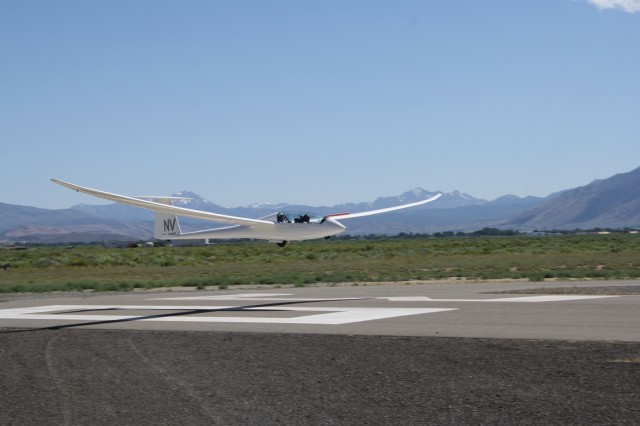
With airbrakes out, a Duo Discus is about to touch down on Runway 30 at Minden-Tahoe Airport – Photo: Soaring NV
But now we have to return to earth. We’re getting lower and lower. We cross the runway threshold, and flare just barely above the runway. I’m holding the controls steady, and we land with a small bump. Wings level with the stick, steer with the rudder, and we head over to the glider staging area as we decelerate, braking to a stop with the airbrakes fully deployed. I close the airbrakes, and then open the canopy. We’ll just sit here for a few minutes, enjoying the quiet and mentally replaying our time in the air. What an amazing flight!!!
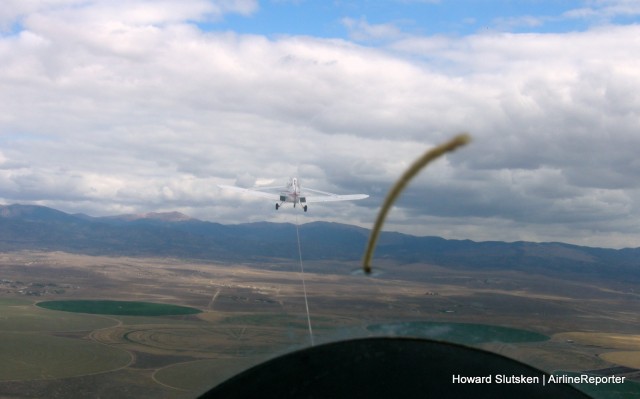
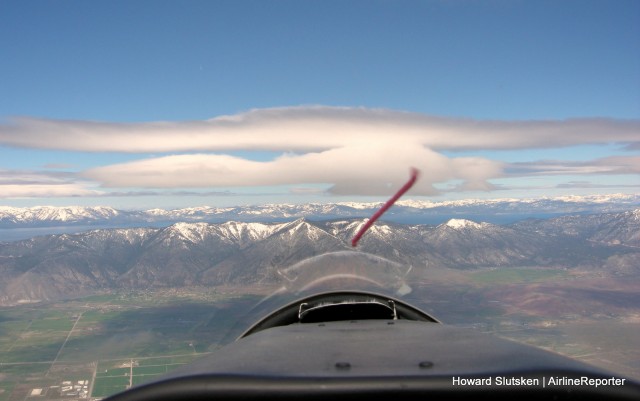
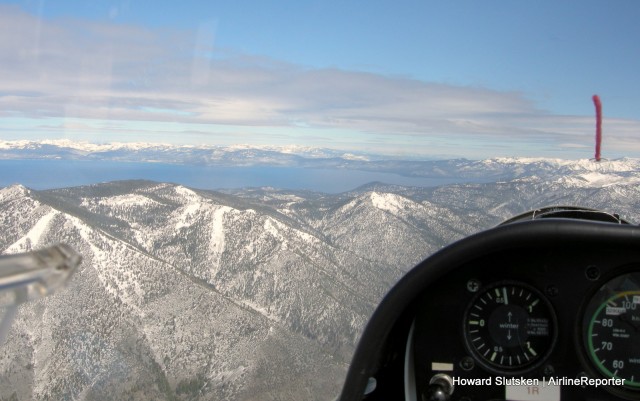
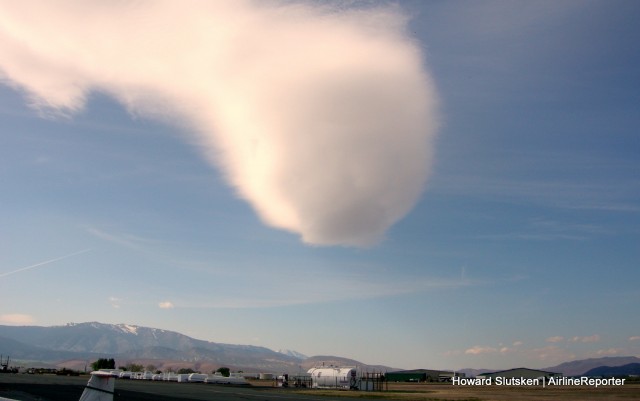
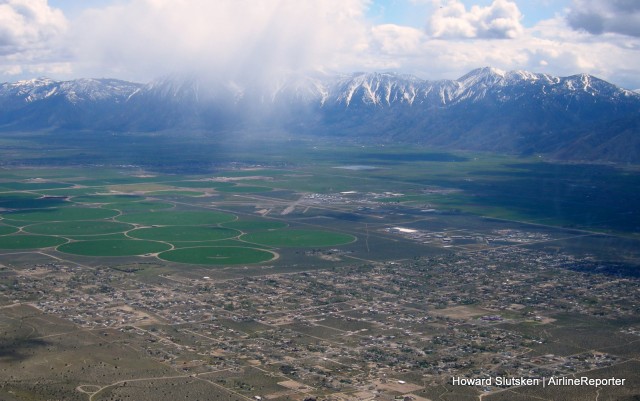
Really nice article, I felt right along with you up in the air.
Excellent series, and very impressive photos – Well done, Mr. Slutsken!
As the above comment implies, it was really fun to “ride along” on your flight…
Thanks so much for a fascinating series of articles! I loved the amount of detail, and felt like I’d come along for the ride. I’d been interested in soaring before, but now you’ve really gotten me excited.
Beautiful description of what must have been a great flight.
Great article, Howard! I remember that tow very well, and the fact that you stayed right behind me in the tow plane. I don’t do as much towing these days, but I’m still there at the back end of the rope enjoying great thermals and wave out of Minden. Thanks for the article!